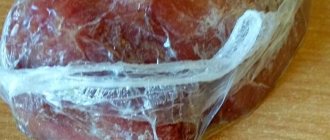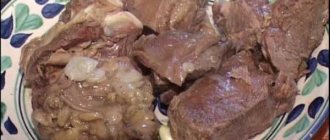Methods for storing meat without refrigeration that will help us keep a supply of our own prepared meat at home all year round.
Ever since the first people on Earth engaged in primitive hunting and gathering, their very survival could often depend on whether they were able to save meat - their main source of protein - for a rainy day.
And they succeeded! In winter, they buried part of their prey in the snow, and in the hot summer, they dried it until it crunched in the scorching sun. This helped them survive from year to year - in fact, it is thanks to the fact that at one time they succeeded in this that you are now reading this article. Yes, the methods of preparing meat of primitive man may seem quite crude to us - but they work, and are successfully used even now. The only difference is that our technological progress has freed us from the need to rely on the mercy of nature for this.
Even now, when it would seem that both fresh and canned meat are available to us all year round, keeping a supply of homemade meat at home may not be such a bad idea - you never know what may await you tomorrow. In addition, in the modern world, preparing meat for future use means knowing exactly what will end up on your plate.
Ice
If you need to transport fresh meat over long distances and do not have a cooler bag, use ice. Pour the ice cubes into a tightly sealed container and immerse the pulp in them. It is advisable to freeze it first. Wrap the container in a thick towel or other fabric - this will slow down the ice melting process.
Depending on the ambient temperature and the possibility of regularly replacing melted ice, the duration of safe storage of meat in such conditions ranges from 3-4 hours to 2-3 days.
We recommend using the described method for storing fresh lamb and beef.
Procurement of meat in modern conditions
Despite the fact that in cities and villages fresh and frozen meat is almost universally available all year round, this does not mean that it is time to forget about ancient technologies for preparing and storing meat. Firstly, such preparations allow people to be prepared for any emergency situations. Secondly, in the era of processing any food with chemicals and harmful substances, the methods of our ancestors help to maintain confidence that only environmentally friendly meat ends up on the plate.
Representatives of isolated tribes still prepare dried, smoked or frozen meat and fish. These methods have found application and even popularity in technologically advanced places, the only difference is that technology makes it possible to prepare meat in ancient ways, without relying on the vagaries of nature.
Thermal package
There are situations when you need to take some boiled meat with you as a nutritious and tasty snack, for example, when going on a long train journey or a multi-day hike. In this case, you should use cooling devices:
- The thermal package can keep meat fresh for up to 14 hours;
- cold accumulators allow you to transport frozen food;
- Thermal bags maintain food temperature for up to 24 hours.
Proper storage of meat
It is permissible to store meat products in a cold place. And the shelf life will correspond to the specific variety and processing method.
There are several options for storing meat products, including freezing. And each of them is based on certain standards, clearly defined in the relevant GOSTs.
Taking into account the qualities and characteristics of a particular product, the storage temperature of meat is kept in the range from -30°C to +5°C.
Vinegar
For short-term storage of pork and beef, it is necessary to place it in an acidic environment. This will prevent the risk of bacteria developing. You can do this as follows:
- soak the meat in 9% vinegar;
- Wrap the fillet thoroughly in a clean cotton or cotton cloth;
- Place the bundle in a container with a tight-fitting lid and put it in a shady place.
The cloth soaked in vinegar should be replaced every 10-12 hours.
Please pay attention! Do not allow a lot of juice to accumulate at the bottom of the container - this will lead to premature spoilage of the product. Remove excess liquid with napkins in a timely manner.
You can store meat using this method for two days.
Security measures
No matter what method of preparing and storing meat you choose, its success depends entirely on the quality of the meat and compliance with all safety rules. Choose only fresh meat and prepare it immediately after purchase, hunting or slaughter. If you need to temporarily postpone preparing meat, store it correctly - in the refrigerator (less than one day) or in the freezer.
How do you store meat?
Found a violation? Report content
Nettle and bird cherry
If you are going outdoors and want to keep a piece of meat fresh without the risk of poisoning, avoid using sour cream or mayonnaise as a marinade. For these purposes, it is better to use vinegar, lemon juice or mineral water.
Be sure to separate the pork and beef from the bone and rub with salt. When you arrive at your dacha or other vacation spot, place the container with meat in a cool area, protected from sunlight.
To create an additional antibacterial effect, wrap pieces of meat with bird cherry or nettle leaves. This will significantly extend their shelf life.
Be able to determine quality
It is impossible to save a spoiled product. When planning to use any storage method, make sure it is fresh:
|
|
A detailed description of the characteristic signs of freshness and staleness is presented in GOST 7269-79. The information applies to beef, pork and all types of slaughter animals, including lamb.
GOST 7269-79 “Meat. Sampling methods and organoleptic methods for determining freshness"
On the third and fourth pages of GOST, methods for determining freshness are described in detail.
Salicylic acid
Storing chicken or pork at room temperature can be done using an alcohol solution of salicylic acid. To do this, follow these steps:
- Prepare a solution: dissolve a teaspoon of acid in 500 ml of cold water.
- Cut the flesh from the bone, rinse it and wait for the water to drain.
- Generously soak a piece of clean cotton cloth in the prepared solution and wrap the meat in it.
- Place the packages in an enamel or glass container and close tightly.
Meat can be stored in a salicylic acid solution for up to two weeks.
Freezer storage
Freezing is a good way to increase the shelf life of meat. True, when defrosted it loses some qualities.
The main thing when freezing is not to leave any air in the bag. It is removed as much as possible (it is better to use a vacuum sealer). The bag is sealed, then wrapped in foil and placed in the freezer.
Large parts are wrapped in film to prevent them from freezing to each other.
Each piece of meat is signed (with a marker on the package). With this method, the remaining storage time is immediately visible.
- Poultry carcasses will last for about 1 year, and pieces cut into pieces will last for 9 months.
- Large pieces are stored in the freezer for 6 - 12 months, and cut red meat - from 4 months. up to six months.
- Game is stored from 8 months to 1 year, various types of minced meat - 4 months,
- After temperature treatment, any meat is stored for 2–6 months.
Burning
One of the good methods of preserving the freshness of fresh meat outside the home is roasting it over a fire. You can do this in the following way:
- Divide the tenderloin into medium pieces;
- string the slices onto a skewer or thick wooden rod;
- keep the meat over the fire, turning the skewer periodically until the pieces are covered with a thin crust on all sides;
- Wait until the meat slices have cooled and place them in a clean container, covering them with a paper or cloth towel.
Processing pork and chicken in this way will extend their freshness outside the refrigerator for 1-2 days.
scalding
If you need to preserve meat in the summer, you can use the following method:
- Prepare a solution based on a liter of water and 5 tablespoons of salt.
- Place the tenderloin in the boiling salt solution.
- Bring the liquid to a boil and cook the fillet for 2-3 minutes.
- Remove the meat from the boiling water and wait until it cools.
- Place the cold pieces in a suitable sized container and store in a cool, dark place.
Boiled meat remains suitable for consumption for two days.
Salt
Salt crystals are the best preservative for any type of meat, which helps extract excess liquid from it and protect it from bacteria.
Salting can be carried out using two methods: dry and wet. Dry salting is carried out as follows:
- cut the meat into thin pieces;
- rub the slices with salt on all sides; in addition, you can use various herbs that will give the product an original taste;
- put the pieces in a container in layers, sprinkling with salt;
- place a press on the workpiece for better salting.
The duration of salting using the dry method is 2-3 weeks.
Wet salting involves preparing a solution in a proportion of 10 tbsp. spoons of salt per half liter of water. The meat is soaked in brine for 24 hours, after which the pieces are tightly placed in glass jars, filled with salted liquid and closed with a lid.
The shelf life of salted meat reaches 3 months.
You can prepare various dishes from the preparation: soups and solyankas, goulash, gravies. Before cooking, the pulp should be soaked in water for several hours.
Drying
Long-term storage of meat without a refrigerator may be necessary if you go on a multi-day hike or if you live in a summer cottage without electricity. In this case, chicken fillet or beef tenderloin must be dried.
Before you start drying the meat, it must be properly processed. To do this, the pulp is cut from the bone and soaked in a salt solution for a day. After this, the fillet is cut into thin strips along the grain, salted and rubbed with spices. The fat must be cut off, since it will taste bitter after drying. For this reason, the method is not suitable for preparing pork.
We will present several drying options so that you can choose the most suitable one:
- In the sun. Meat slices are strung on a strong thread and hung in the open air so that the sun's rays fall on them. With this storage method, it is important to ensure that insects do not have access to the meat or, if it is not possible to hang them outside, that the room is well ventilated.
- In the oven. Place strips of meat on a baking sheet at a short distance from each other. The tray is placed in an oven in which the minimum temperature is set. The duration of drying beef is 8-10 hours. The air temperature in the oven should be maintained at the same level at all times, and the door should be slightly open to allow moisture to evaporate.
- Over the fire. Under natural conditions, a fire made of hardwood is built to dry meat. After the wood has burned, slices of meat are hung over the coals, and a hut of branches and leaves is formed on top. To ensure consistent smoke production, wet wood chips should be added to the coals from time to time. The average drying time is 8-9 hours.
- Drying minced meat. Fresh meat must be minced in a meat grinder. Place the resulting minced meat on a baking sheet, add salt, sprinkle with spices and dry until hardened. The pieces should be stirred from time to time to ensure even drying.
Dried meat can be stored in tightly closed containers for quite a long time - up to two months.
What does quality meat look like?
A high-quality fresh product can be recognized by the condition of its cut. In this case, consistency, color and aroma are important. The meat must have a uniform color: without fragments of other shades or spots, and the color must correspond to the species:
- lamb has a natural color - dark red;
- beef is red, and calf is pink;
- the pork should be pink;
- poultry – light meat with a pink tint.
The composition may contain streaks and small areas of fat.
A quality product can be recognized by its fresh, pleasant, barely noticeable aroma. A sour, pungent odor indicates that the product is stale.
Inclusions of white fatty layers, which have a marble-like pattern at the cut site, indicate high quality and freshness. The exception here is lamb fat: it can be creamy in color.
The consistency of good quality meat should be dense and elastic. When pressed, it should immediately return to its original position (spring). The indentations at the place of pressure should not remain.
There cannot be any mucus (not to mention mold) on the surface of a quality product.
When choosing in a store, you need to make sure that there are no smudges at the bottom of the package. This is an indicator of a low-quality product: defrosted several times or simply stale.
Small pink ice crystals located around a piece of frozen meat also indicate temperature violations during storage.
Raw meat that has a grayish tint definitely should not be purchased. Even if its packaging has a fresh release date. This product should also not be eaten. This may cause serious poisoning.
Trade workers have many ways to make expired goods look beautiful. For example, areas of pink fat indicate soaking in potassium permanganate.
In stores, as well as in markets, the degree of product quality is determined using pressure. Repeatedly thawed meat will remain dented. In this case, the cavity will immediately fill with liquid. And fresh food will immediately restore its original shape.
Conservation
Canning meats is the longest storage option that does not require refrigeration. The shelf life of homemade stew reaches 2-3 years.
There are two ways to preserve meat:
- Hot. The pulp must be cut from the bone and cut into small pieces, put in a saucepan, add water, bring to a boil and cook with salt and spices until it begins to separate into fibers. At this time, glass jars should be thoroughly washed and sterilized. The cooked meat should be placed in jars, lightly compacted, and filled with broth. Roll up the jars and wrap them in a blanket to cool slowly.
- Cold. The meat is cut into pieces of the same size and placed in jars in dense layers. Each layer of pulp is sprinkled with salt. The jars are rolled up with lids and sterilized for at least 1 hour.
It is advisable to store canned meat in a cool, dark place.
The length of time that raw meat is stored depends on the temperature at which it is kept. So, on one of the refrigerator shelves, tenderloin or fillet will remain fresh for 48 hours, in a zone with a temperature of 0˚…+1˚ Celsius – up to 72 hours. At room temperature, meat will remain fresh for no more than a day. In this case, it is advisable to remove it from the bag, place it in an enamel container and place it in the coolest place, protected from sunlight.
To extend the shelf life of chicken, pork or beef for a significant time, they will need to be processed - salting, drying or canning. If you need to keep the product fresh without refrigeration when traveling long distances, you can use various methods of processing it - soaking in a saline solution, wrapping with nettle or horseradish leaves, rubbing with melted lard.
For storage without refrigeration, you must use fresh meat, processing it using one of the listed methods immediately after purchase.
Video: how in Rus' they kept food fresh without refrigerators
How in Rus' they kept food fresh without refrigeration
Watch this video on YouTube
Video: meat preservation
MEAT PRESERVATION (long-term storage)
Watch this video on YouTube
Do you want to understand better than others?
- How can you keep food fresh without a refrigerator: top 17 ways - If the refrigerator malfunctions or in the event of a prolonged power outage, most housewives wonder how to keep food fresh. The heat promotes...
- How to freeze peaches for the winter: 8 best ways - Freezing will help you preserve a delicious piece of summer. Find out how to choose the right fruits for vitamin preparations, whether they can be stored in the refrigerator, what ways there are to...
- How long can marinated meat be stored in the refrigerator - It happens that plans change and it is not possible to cook the meat prepared in advance. How long does marinated meat stay fresh in the refrigerator in various marinades? How many…
- How to keep strawberries and strawberries fresh in the refrigerator - You can enjoy strawberries not only in the summer, but also in the cold season. The main thing is to properly preserve the ripe berries. One of the best ways is to freeze strawberries for…
- How to keep cheese fresh for a long time in the refrigerator - According to GOST, natural cheese does not contain preservatives, therefore, the shelf life of the product ranges from several days to a year if properly followed...
Salting
Table salt is a dehydrating agent that helps preserve meat above freezing temperatures. Salted meat can be stored for a long time, since salt has antimicrobial properties.
It’s good to wash often: myths about shampoo and hair care that only harm
If there is little snow, there will be no harvest: December 16 is Ivan the Silent Day
Women's jeans: before you buy them, you need to pay attention to one detail
Salting meat can be done in different ways. A popular method is dry brining, a method in which the meat is simply rubbed with a large amount of salt and the juices are allowed to drain. To do this, you can use simple table salt, which can be mixed with spices and herbs to add flavor to the meat.
In addition, the meat can be rolled into jars with a salty solution, to which honey or even sugar is added for additional taste.
Another interesting method of dry salting is that before salting, the meat is stored in a marinade, and after it is rubbed with salt, the meat is dried in the sun or in a dehydrator.
It is worth noting that there is a special salt on sale for salting meat and fish. It softens the texture of the finished product, but does so by mixing the salt with chemicals such as 6 percent sodium nitrite. This chemical can be harmful to the body if its content in food exceeds the permissible limit, therefore, when using special salt mixtures, carefully follow the recommended proportions or give preference to simple table salt.











